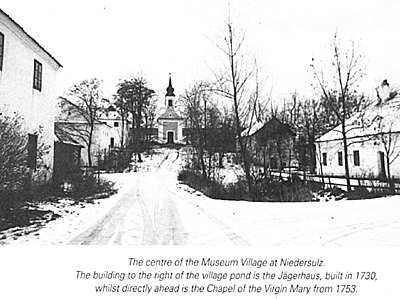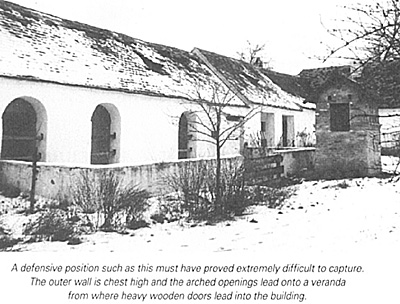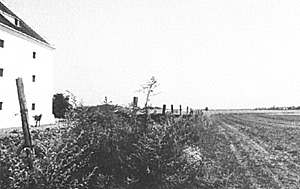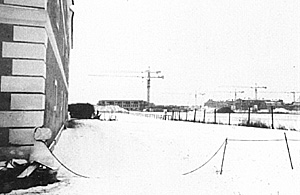
A series of articles designed to make us think about what exactly we are trying to recreate both in our re-enactments and on a wargames table. In the following article, Ian Castle looks at the Museum Village of Niedersulz on the Marchfeld.
The centre of the Museum Village at Niedersuiz. The building to the right of the village pond is the Jagerhaus, built in 1730, whilst directly ahead is the Chapel of the Virgin Mary from 1753.
Over the last couple of years there has
been a perceptible increase in interest in the campaigns of Napoleon against
Austria. The growth in the number of books, magazine articles, wargame figures,
etc. on the subject is refreshing. Perhaps more so because in many cases the
Austrian Army is now being looked at in a new light. The old stereotype view that
the doddering, inept Austrians were just there waiting to collapse before the first
glorious French onslaught is at last being dispelled. The campaign of 1809 in
particular shows the Austrian troops as dogged, brave fighters, able to hold their
own against the most ferocious French attacks.
Some of the fiercest fighting of this campaign occurred in the small
picturesque villages of the Marchfeld, north-east of Vienna. The names Aspern,
Essling, Deutsch-Wagram, Aderklaa, Baumersdorf and Markgrafneusiedl all
conjure up images of these monumental struggles. Amongst the houses,
gardens and cemeteries of these smokefilled villages, soldiers struggled for
hours in an effort to gain the upper hand and dislodge or repulse their opponents
once and for all. But what did these villages look like and why did they prove so
difficult to capture and hold?
Normally, the passing of time and the devastation of the battles themselves
have combined to make it impossible to view this type of village as it would
have appeared almost 200 years ago, and therefore to get a feel for the fighting
that took place in them. However, help is now at hand. On a visit to Vienna in
January 1995 1 was taken by my host to the Museum Village at Niedersulz,
about forty minutes drive north-east of the city. Here history has been
preserved in the most remarkable fashion.
The idea behind the creation of the village has its roots in the 1960's when
Josef Geissler, a local builder and restorer, began collecting local rural antiques
and equipment of this wine growing region. As the collection grew, he formed it
into a village museum. Growing concerns about the rapid destruction of many
old buildings in the area led in 1978 to the purchase of one such building, the
Steckhof, in the nearby village of Bad Pirawarth by Geissler and the Weinviertel
Museum Association. This building was then dismantled and re-erected in
Niedersulz where it housed Geissler's collection. From then on, the project
rapidly expanded. More and more old buildings from the local district, due to be
lost forever, were acquired and moved to Niedersulz where they were
painstakingly rebuilt brick by brick and stone by stone, That first building is now
surrounded by forty-three others, forming a fine village which can boast a pub,
a blacksmith, a village pond, two chapels and even a cemetery.
The majority of buildings in the village are perfect for the Napoleonic
period. The earliest dates from 1704 while the later examples are from the
middle of the nineteenth century. A closer inspection of the buildings
themselves immediately gives a better understanding of the difficulties
experienced in clearing a village of this type. Extremely thick walls with
small, heavily shuttered windows and heavy wooden doors make for good
defensive positions. Some of the buildings also have chest-high outer stone
walls enclosing small gardens. After wandering around the village you come
away with the impression that each and every building would serve as a
perfect defensive strongpoint. The fighting in these villages was hard,
vicious and unrelenting. It is easy to see why.
The village is a delight to visit, although I do not recommend it in
January in snow and ice with a biting wind whistling round the out buildings!
In the summer, the Museum Village officially opens to the public, and it is
possible to go inside many of the buildings which are furnished and equipped
from Herr Geissler's collection. In addition, parts of the Village are populated
during certain weekends of the summer when I understand the baker's shop
has trouble meeting demand for the bread it bakes on site.
Niedersulz is a fine example of preserving the past, but wherever
there is a plus there is a minus. A few days later I visited the village of
Essling and the massive Granary which itself saw such heavy fighting during
the Battle of Aspern-Essling in May 1809. Cut off at times from the rest of
the French Army men of Boudet's Division held out within its massive stone
walls against repeated assaults by both Austrian IV Korps and four Grenadier
battalions from the Reserve.
For years this part of the Marchfeld has been largely untouched by
modern developments but sadly this has now ended. As you can see in the
photograph, the scourge of all battlefields has finally arrived: the property
developer has moved in. The City of Vienna has an urgent need for new
housing, but natural features prevent expansion of th city in other directions.
The historic Marchfeld, a vast flat plain, is apparently the only viable solution,
and it is hard to argue against it from a practical point of view. So the cranes,
the excavators and the diggers have moved in and the houses have started to
go up, erected directly in the path taken by Decovich's Fourth column as it
moved against Essling.
But perhaps the ghosts of the soldiers who bravely fought and died
here have made one last effort to resist the relentless advance of time. The
developers have run out of money and any further incursion on the battlefield
has been halted. But it is probably only a temporary halt. No doubt when
money is again available the buildings will resume their inexorable advance and
this unique vantage point of the battle will sadly be lost forever. As an interest
in the 1809 campaign grows it can only be viewed with deep regret that our
physical links with its story are becoming weaker.
 A defensive position such as this must have proved extremely difficult to capture.
The outer wall is chest high and the arched openings lead onto a veranda from where heavy wooden doors lead into the building.
A defensive position such as this must have proved extremely difficult to capture.
The outer wall is chest high and the arched openings lead onto a veranda from where heavy wooden doors lead into the building.
 The view across the Marchfeld from the Granary in Essling. The photo at right was taken in the summer of 1992 and shows the land much as it would have appeared in 1809.
The view across the Marchfeld from the Granary in Essling. The photo at right was taken in the summer of 1992 and shows the land much as it would have appeared in 1809.
 The photo at right was taken between blizzards in January 1995 and shows the new building
work which is now encroaching on this part of the historic battlefield.
The photo at right was taken between blizzards in January 1995 and shows the new building
work which is now encroaching on this part of the historic battlefield.
Back to Age of Napoleon 19 Table of Contents
Back to Age of Napoleon List of Issues
Back to MagWeb Master List of Magazines
© Copyright 1996 by Partizan Press.
This article appears in MagWeb (Magazine Web) on the Internet World Wide Web.
Other military history articles and gaming articles are available at http://www.magweb.com